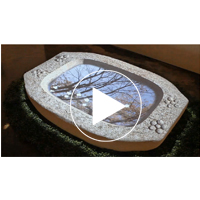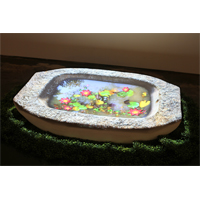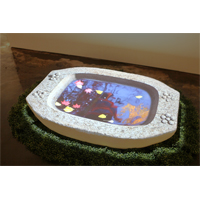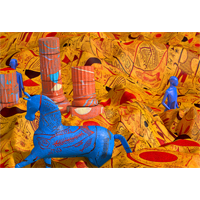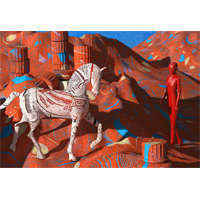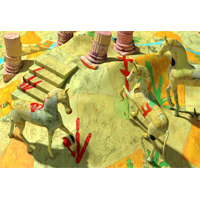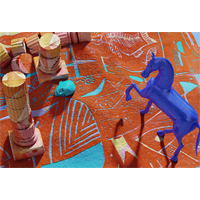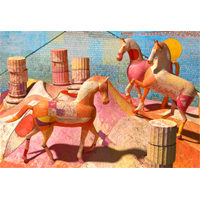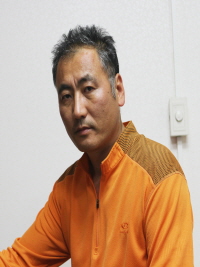
Chang Kyum KIM, Savina Museum of Contemporary Art
Birth
1961, Yeoju, Geonggi-do
Genre
Installation, Photography, Media
Homepage
The Fissure and Gap Between Reality and Illusion
Online exhibitions of Chang Kyum Kim’s images and photographs adopt a wide range of materials and devices, but the crux of his work has been faithful to the basic theme of presenting the fake as real, the false as true, and illusion as reality since 2000. His work received public recognition with the exhibition titled, Sarubia Dabang in 2003, but his principal experiment takes place with his series of still lifes. While studying in Italy, Kim was greatly inspired by the still-life paintings by Giorgio Morandi (1890-1960) who, together with Giorgio de Chirico, were representative painters of metaphysical art, or “pittura metafisica” in Italian. Kim discovered that in still life, a reference to Natura Morta, there are the residues of past memories in a frozen time frame, which he depicts as ‘the memory of absence’ in his photographs and images. As is certainly the case of the visual arts, even technology, with its constant progress, cannot escape its status as empty signifiers as they are both language bound. Thereof, objects do not function as the core of language, but are relegated to function as an alibi, annotated in parenthesis. And nature morta, the antiquated representations from Classicism, became an appropriate metaphor for contemporary art and culture for the artist. In his Dusseldorf exhibition in 1997, Kim presented his experimental works for the first time. He first took pictures of common objects, carved them out of plaster, and drew images on the surfaces of the carvings with a pencil. These were fabricated sculpture; they had the material properties of plaster but their actual sizes were different as the objects were based on photographs, and the table on which the objects were placed floated in mid-air. As each object lost its color, its weight disappeared. Through a process of image making, the original object became open to unlimited possibilities for fabrication, and Kim’s following output befalls to a game played out between reality and illusion.
In his early work, The Pedestal for Images (1998), the textures of one stone is projected onto the surface of another, expressing the object as transformed into simulacra. It is the body of the viewer that exposes the realistic-looking surface as fake when he disrupts that image, casting a black shadow over the real stone. This work demonstrates that the more splendid a surface becomes, the more likely the real (“real” refers to both the object and viewer) appears ghostlike. In this spectacle, which gains autonomy through a kind of fabrication, the viewer is nothing but a shadow stealthily cutting into the image, while the body of the original stone is but an inactive, plain mass. This basic dynamic is found in his later works which deal with individual and communal memory. Kim’s oeuvre has dealt with the absence of the real that underlies the aesthetics of still life and photography, but the real is only one of its many codes and cannot easily be abandoned. The real is inseparable from the traces deeply carved into the artist’s body and soul, from which his actions and thoughts derive. Discontinuity lingers between these codes, like stage lights going black between scenes, and within this discontinuity meaning can be found. For example, Letter (2000), a video installation, sets up a situation in which a man writes a letter to his past self from 20 years ago, whence he remembers his first love. The objects in the video change into various forms as Kim stretches his imagination writing the letter, but as he finishes, only the seedy castings resembling the objects remain. The letter is read in a soft monologue, ‘Nevertheless, what I have been dying to ask is… did you really exist there as I think you had? Did you really exist? Did I really exist?’ The real is as intense as the first love that cannot be held.
Kim attempts to take a step closer to an improbable reality by evoking the passage of time and communal memories. In Water Shadow?Four Seasons (2006-2007), noted as his major video installation, the artist depicts four seasons on a small, artificial pond. In Sarubia Dabang, he projected incarnations of communal memories related to the dabang, a traditional tea room. The frame of a mirror, which left a deep impression in the exhibition, reappears in The Mirror exhibition at the Sabina Museum of Contemporary Art in 2007. His work, Memory in the Mirror (2006-2008) shows that the mirror, used to link broken body parts in a virtual way, holds relevance to the illusion of an individual trying to meet social demands. As in the majority of Kim’s works, illusion is as vulnerable as the real; illusion and the real do not simply exist as a dichotomy, but are rather mates, each with its own center. Some of his works that project his image onto that of great figures, including Honoring van Gogh (1998-1999) and Like a Mao (2004), illustrate the similarity between the mirror and the golden frame of a portrait. As the subtitle of his recent exhibition in Korea, Natura Morta (2010) suggests, he seems to return to the still life. The video installation, Still Life (2007), which was first shown at the Sabina Museum exhibition, is recreated in a different version; one small shelf on the wall of the museum is empty while another is decorated with a variety of bottle-shaped frames. As a fairy-like girl in the video plays around and runs in and out of the bottles like a butterfly, the bottles change color. The fairy exhibits a strong element of fantasy, however, there is the metaphor that a human being animates these once lifeless objects. In the other version, the girl appears and disappears suddenly and turns into a variant form of herself. Objects in the work are all different in scale, and throw shadows in various directions.
A revised version of Still Life (2010), using single-channel video, consists of images and photographs of artificial images pasted onto a photograph serving as a rough draft sketch. This new Still Life is pleasurable rather than contemplative. Rather than hovering in between the real and fictional, it is more definitely fictional. There is a dynamic between something hypothetical and something real even in the hyper-real world that absorbs all objects, humans, and nature, yet the world on screen is more homogeneous. It is a new reality (language) of the postmodern era that rearranges everything in similar codes by keeping a great distance between itself and the real world. To the homo loquens species, reality does not exist onto itself but is always constructed through language, and therefore deconstruction is the flipside of construction. It is an aesthetic and political choice to introduce discontinuity to a linear order that assumes ongoing progress. This is because realism is nothing more than the manifestation of the bourgeois desire to cling to the concrete. Although realism asserts rationality in the world and the possibility of representation, “the factual” itself can be altered through observation or interpretation. In Kim’s works, reality is depicted as a delimited structure, not an eternal one. Kim exposes the looseness of the fragile joints that hold together a constructed reality. As Suzi Gablik puts it when analyzing Rene Magritte, “representation is a complex process which involves more than mere mirroring, or the imitation of objects. It is a symbolic relationship that is both relative and variable.” Kim’s language is not a transparent medium that mirrors reality but a kind of tool that undermines conventional modes of representation. His works expose uncertainty inherent in an objective world. To unveil this uncertainty, he starts with the most common objects. Familiar things are used as the background upon which images are projected, such as a mirror, fishbowl, broken plate, saucer or bottles; a vast array of objects, including toys, appear in the most recent editions of his Still Life sequel.
Rene Magritte adopted a similar strategy of paradoxical combination of precision and imprecision, and defined the components of his work as “an object, the thing attached to it in a shadow of my consciousness, and the light under which that thing would become apparent.” Rene Magritte’s method is “a systematic attempt to disrupt any dogmatic view of the physical world” (Suzi Gablik). Representation, a mechanism which operates with precision in Kim’s artworks, is related to deconstructing representation. This is a strategy of denying representation by means of representation. The obtrusion of a black hole into the real in Kim’s work declares that reality itself is fabricated. Meaning may not reside in the thing itself in an artwork, but it certainly resides within the mind (Alain Robbe-Grillet). The bleak models that appear when the lights go out constitute the viewers experiencing of the object, different from a simplistic projection or reflection of the object. The main viewing experience of his work is this sudden awakening that follow moments of pleasurable contemplation. The fissures of reality, which are revealed through timing and spatial differences, seem rather real. If reality is something alive, it should not be a closed structure but an open one. According to Suzi Gablik, “the more stereotyped these labels and their usage, the more likely it is that the represented will be confused with the representation. The resulting confusion is generally called ‘realism’: when it is present to the highest degree, the two are indistinguishable.” The grammar of “fissure” and “gap” works assertively in Kim’s art, yet it is another form of chaos that exposes the chaos inherent in artlessness. It is a kind of homeopathy independent from a binary conception of reality and fiction.
Seonyeong LEE (Art Critic)
Get Lost Between Reality and Image
“One day Zhangzi became a butterfly in his dream. Whilst enjoying a joyous fly in the spotless air, he forgot whether he was Zhangzi or a butterfly. After he woke up, he finally realized he was Zhangzi.” This is a famous anecdote from Zhangzi’s Taoism theory. Here Zhangzi raised a question whether “he became a butterfly in his dream or vice versa.” Although the purpose of this question is to warn us of the danger of premeditated discrimination, it also helps us to understand the question of representation in art or the relation between reality and image. While this story is based on epistemological dimension, the representation of reality can find its origin from its phenomenological aspect. However, considering the fact that perception and phenomenon are closely interconnected like a circle, it is not worth pointing out disparity between them.
Changkyum Kim’s work is about the question of representation. The answer to this question is displayed through the exploration of the relation between reality and image. Image of contemporary era refuses to be defined within the context of art only; it is a kind of social index which can be consumed in political context in various forms. Kim’s interest in image covers more than art. To him, image is the representation of reality which functions as a sort of image-generator within the context of art, and at the same time, it can also be interpreted as symbols of political, social, and economical environment which help images to be consumed and circulated.
“I gave up sculpture because image took priority over reality,” said Kim. This sentence reminds me of Jean Baudrillard’s comments on modern society such as “images without origin,” “images which is more realistic than reality,” and “image that substitutes reality.” And the way he sees reality as a mere image takes me back to old philosophers’ idea that defined an ephemeral being as a shadow of eternal being. Kim’s strong skeptical view on reality constitutes the philosophical base behind his art and provides conceptual aura.
Since his skepticism toward reality comes from his real experience rather than a mere conceptual play, what he want to say becomes very clear on the basis of solid logic and appealing sympathy. For example, Kim sees the whole procedures of his artworks in which involve his intense labor and invisible spirit projected onto the process as the core of his sculpture, while viewers’ interest is only focused on the aesthetical pleasure of the consequences such as materials, shapes, and colors.
Taking out Cube
Pedestal for An Image; 1997~1999
Moreover, viewers’ interest in imitation creates meta-sculpture or a newly emerging image of sculpture from a model. Meta-Sculpture and Meta`-Sculpture; 1997~2000
Among Kim’s series of Van Gogh paintings, Homage to Admiration Toward Van Gogh 1, 2; 1998-1999
Choonghwan GOH (Art Critic)


















